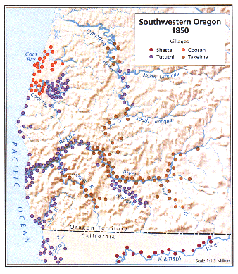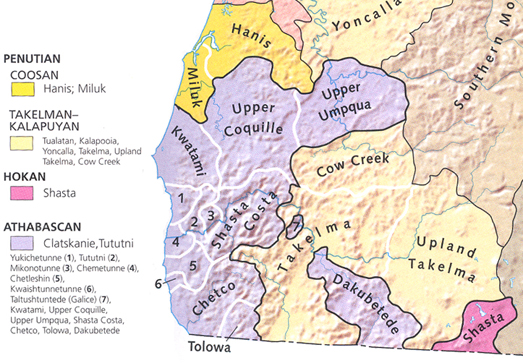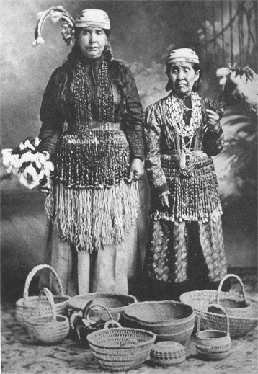| Library | Lane | Search Lane | Catalog |
| Contact Us | Web Site Accessibility |

| Don Macnaughtan | Lane Community
College Library Eugene, Oregon 97405 macnaughtand@lanecc.edu |

Discography and bibliography of the Athapaskan Indians of Southwestern Oregon
© 2010 Don Macnaughtan
Ethnographic Bibliographies no. 3
Introduction
Map of ethnic distribution in southwest Oregon
 Chinookan Oral Literature Bibliography
Chinookan Oral Literature Bibliography Bibliography of Oregon Athapaskan Languages
Bibliography of Oregon Athapaskan Languages
 Indian Languages of Western Oregon
Indian Languages of Western Oregon
This short discography lists and annotates all the known recordings in the languages of the Chetco, Shasta Costa, Tututni, Upper Umpqua, Upper Coquille, and Galice-Applegate peoples of Southwest Oregon. Most of these recordings are unique wax cylinders, acetate discs, or aluminum discs held in archives in Washington DC and Seattle. In many cases, tape recordings are available for tribal members and researchers. There is also an accompanying bibliography about these interesting and unusual people.
These people were Athapaskan Native Americans, who originally migrated into this area over two millennia ago from northern Canada and Siberia. They are a distinct group who probably arrived from Asia in a separate, later migration from most Native Americans. They are linguistic relatives to groups in Northern Canada and Siberia, as well as the Navajo and Apache in the Southwest. Their name for themselves - "Tunne" - is cognate with the Navajo "Dine." At some point, they split off from the southward migration of the Athapaskans, and settled into these remote pockets of land. How they found their way here is something of a mystery. Their descendants still live in Oregon today.

The Southwest Oregon Athapaskan Tribes
The Athapaskans who lived along the coast of southwest Oregon are collectively known as Chetco-Tututni, and were (from north to south):
 the kwatami tunne people on the New River, Floras Lake and the Sixes River (8 villages)
the kwatami tunne people on the New River, Floras Lake and the Sixes River (8 villages) the yukiche tunne people at Euchre Creek (1 village)
the yukiche tunne people at Euchre Creek (1 village) the toto tunne, mikono tunne and cheme tunne people along the Lower Rogue River (22 villages)
the toto tunne, mikono tunne and cheme tunne people along the Lower Rogue River (22 villages) the chetleshin tunne on Pistol River (1 village)
the chetleshin tunne on Pistol River (1 village) the kwaishtunne tunne on Lone Ranch Creek (1 village)
the kwaishtunne tunne on Lone Ranch Creek (1 village) the chedi tunne or Chetco along the Lower Chetco River (10 villages)
the chedi tunne or Chetco along the Lower Chetco River (10 villages)Athapaskans in the interior of southern Oregon were:
 the mishi kwutine tunne or Upper Coquille along the Coquille River (28 villages)
the mishi kwutine tunne or Upper Coquille along the Coquille River (28 villages)
 the etnemi tunne or Upper Umpqua people in the Umpqua Valley (8 villages)
the etnemi tunne or Upper Umpqua people in the Umpqua Valley (8 villages)
 the shista quista or Shasta Costa in the Rogue River Gorge (13 villages)
the shista quista or Shasta Costa in the Rogue River Gorge (13 villages)
 the taldash tunne dade or Taltushtuntede along Galice Creek (2 villages)
the taldash tunne dade or Taltushtuntede along Galice Creek (2 villages)
 the dahkohbe dade or Dakubetede in the Applegate River Valley (18 villages)
the dahkohbe dade or Dakubetede in the Applegate River Valley (18 villages)
 the gusla dade people in the lower Illinois River Valley (4 villages)
the gusla dade people in the lower Illinois River Valley (4 villages)
 the he nag gi living along the Lower Smith River (8 villages)
the he nag gi living along the Lower Smith River (8 villages) the toli owa living around Lake Earl (4 villages)
the toli owa living around Lake Earl (4 villages) the ta ta tenne people at Elk Creek (1 village)
the ta ta tenne people at Elk Creek (1 village)
Discography
- These recordings are held in the American Folklife Center, Library of Congress (cylinders no. 884-897, tape nos. AFS 18,471 and 22,169). The recordings were made at the end of 1915 from Billie Sampson, Bensell Orton, Hoxie Simmons, and Archie Johnson at Siletz. There are songs in the Galice Creek, Chasta Costa, and Tututni Athapaskan languages. In addition, cylinder no. 888 is in the Umpqua Athapaskan language from Jack West, August 1915. Thirteen of the songs by Hoxie Simmons have been dubbed to tape no. AFS 22,169, and 27 of the remaining songs are archived on tape no. AFS 18,471 (see the Archive of Folk Culture web site.) All the recordings are indexed in The Federal Cylinder Project: A Guide to Field Cylinder Collections in Federal Agencies, Volume 3. Ed. Judith A. Gray. Washington: American Folklife Center, 1988. 279-286.
- Audiotape recording (no. LA 143) in the Berkeley Language Center, University of California at Berkeley. The wordlist recording is of fair quality, and has extensive documentation.
- Recordings no. 14705-14725 in the Melville Jacobs Collection, University of Washington, Seattle.
- Recordings no. 14726-14729, 14740-14751 in the Melville Jacobs Collection, University of Washington, Seattle.
- Seven audio cassettes of Coos and Athapaskan material from the Melville Jacobs Collection held at Southwest Oregon Community College Library, Coos Bay.
- Recordings no. 970-1003 in the John Peabody Harrington Papers, National Anthropological Archives, Washington DC. Tape recordings of this set were presented to the Coquille Indian Tribe by the President of the University of Oregon in May 1998.
- Recordings no. 1097-1116 in the John Peabody Harrington Papers, National Anthropological Archives, Washington DC.
- Recordings no. 1244-1257 in the John Peabody Harrington Papers, National Anthropological Archives, Washington DC.
- Audiotape recording in the Anthropology Archives, Washington State Museum, Seattle.
- Audiotape recordings reputedly held at Portland State University, Portland. The tape has apparently gone missing in the last few years.
- Audiotape recordings held at Portland State University, Portland. Fate unknown.
 Frachtenberg, Leo J.
Tututni Indian Music. 1915. 14 wax cylinders. 2 10-inch tapes. 50min.
Frachtenberg, Leo J.
Tututni Indian Music. 1915. 14 wax cylinders. 2 10-inch tapes. 50min. Golla, Victor K., and Ida Bensell.
Vocabulary in Tututni from Ida Bensell, Siletz, Oregon. 1962. 27 min.
Golla, Victor K., and Ida Bensell.
Vocabulary in Tututni from Ida Bensell, Siletz, Oregon. 1962. 27 min. Jacobs, Melville, and Coquille Thompson.
Upper Coquille Athabaskan Music and Texts. 1934. 21 acetate discs.
Jacobs, Melville, and Coquille Thompson.
Upper Coquille Athabaskan Music and Texts. 1934. 21 acetate discs. Jacobs, Melville, and Hoxie Simmons.
Galice Creek Athabaskan Music and Texts. 1935. 16 acetate discs.
Jacobs, Melville, and Hoxie Simmons.
Galice Creek Athabaskan Music and Texts. 1935. 16 acetate discs. Jacobs, Melville.
Melville Jacobs Collection: Items 19-28, 43-46. 1975.
Jacobs, Melville.
Melville Jacobs Collection: Items 19-28, 43-46. 1975. Marr, John P., and Coquille Thompson.
Upper Coquille Athabaskan Sound Recordings from Coquille Thompson. 1941. 34 aluminum discs.
Marr, John P., and Coquille Thompson.
Upper Coquille Athabaskan Sound Recordings from Coquille Thompson. 1941. 34 aluminum discs. Marr, John P., and Hoxie Simmons.
Galice Creek Athabaskan sound recordings from Hoxie Simmons. 1941. 20 aluminum discs.
Marr, John P., and Hoxie Simmons.
Galice Creek Athabaskan sound recordings from Hoxie Simmons. 1941. 20 aluminum discs. Marr, John P., and Lucy Smith.
Tolowa-Tututni Sound Recordings from Lucy Smith. 1941. 14 aluminum discs.
Marr, John P., and Lucy Smith.
Tolowa-Tututni Sound Recordings from Lucy Smith. 1941. 14 aluminum discs. Metcalf, Leon V., and Hoxie Simmons.
Tape Recording of Galice Creek Athabaskan Music from Hoxie Simmons at Siletz, Oregon. 1955.
Metcalf, Leon V., and Hoxie Simmons.
Tape Recording of Galice Creek Athabaskan Music from Hoxie Simmons at Siletz, Oregon. 1955. Pierce, Joe E., and Hoxie Simmons.
Galice Creek Athabaskan Words and Phrases from Hoxie Simmons at Siletz, Oregon. 1962.
Pierce, Joe E., and Hoxie Simmons.
Galice Creek Athabaskan Words and Phrases from Hoxie Simmons at Siletz, Oregon. 1962. Pierce, Joe E., and Ida Bensell.
Tape recordings of Tututni Athabaskan from Ida Bensell at Siletz, Oregon. 1962.
Pierce, Joe E., and Ida Bensell.
Tape recordings of Tututni Athabaskan from Ida Bensell at Siletz, Oregon. 1962. Molly Carmichael and her mother Yannah Catfish.
Molly Carmichael and her mother Yannah Catfish. These Tututni women, photographed around 1909,
are dressed in full ceremonial regalia, including
basketry hats, necklaces of dentalium, shell
and beads, and elaborate buckskin aprons
decorated with pine nuts, thimbles, and fringes.
Bibliography
-
1. Beckham, Curt. "Eddie Ned: Gyppo Logger." Oregon Coast Apr./May 1988: 33. Print.
2. - - -. "Indian Signal Pits and Meeting Places." Curry County Echoes Apr. 1980: 7. Print.
3. Bommelyn, Loren, and Berneice Humphrey. Xus We-Yo: Tolowa (Tututni) Language Dictionary. 2nd ed. Crescent City: Tolowa Language Committee, 1989. 488p. Print.
4. Dorsey, James O. "Tututni." Handbook of American Indians North of Mexico. Ed. Frederick W. Hodge. Washington: Bureau of American Ethnology, 1907. 857-858. Print.
5. Drucker, Philip. The Tolowa and Their Southwest Oregon Kin. Berkeley: U of California Press, 1937. 78p. Print.
6. Du Bois, Cora A. "Tolowa Notes." American Anthropologist 34 (1932): 248-262. Print.
7. - - -. "The Wealth Concept as an Integrative Factor in Tolowa-Tututni Culture." Essays in Anthropology Presented to A. L. Kroeber. Ed. Julian Steward and Robert H. Lowie. Berkeley: U of California, 1936. 49-65. Print.
8. Golla, Victor K. "Tututni (Oregon Athapascan)." International Journal of American Linguistics 42 (1976): 217-227. Print.
9. Gould, Richard A. "Ecology and Adaptive Responses Among the Tolowa Indians of Northwestern California." Journal of California Anthropology 2 (1975): 148-170. Print. Rpt. in Native Californians: A Theoretical Retrospective. Ramona: Ballena Press, 1976. 49-78. Print.
10. - - -. "Seagoing Canoes Among the Indians of Northwestern California." Ethnohistory 15 (1968): 11-42. Print.
11. Gratch, Elizabeth. "Tututni." The Gale Encyclopedia of Native American Tribes. Ed. Sharon Malinowski and Anna Sheets. Vol. 4. Detroit: Gale, 1998. 526-528. Print.
12. Gray, Judith A., ed. "Tututni and Upper Umpqua Indian Music: The Leo Joachim Frachtenberg Collection." The Federal Cylinder Project: A Guide to Field Cylinder Collections in Federal Agencies. Vol. 3. Washington: American Folklife Center, 1988. 279-286. Print.
13. Hall, Roberta L., and Don A. Hall. "The Village at the Mouth of the Coquille River: Historical Questions of Who, When and Where." Pacific Northwest Quarterly 82.3 (1991): 101-108. Print.
14. Hahn, Barbara. "Forest Service Researches Ancient Designs on Stones: The Artifacts Provide Insights Into the Spiritual Beliefs of Prehistoric Tribes." Register-Guard 25 Sept. 1994: 8C. Print.
15. Hildebrandt, William R. "Native Hunting Adaptations on the North Coast of California." Diss. U of California at Davis, 1981. 221p. Print.
16. Hoijer, Harry. "Athapaskan Languages of the Pacific Coast." Culture in History: Essays in Honor of Paul Radin. Ed. Stanley Diamond. New York: Columbia UP, 1960. 960-976. Print.
17. - - -. "The Chronology of the Athapaskan Languages." International Journal of American Linguistics 22 (1956): 219-232. Print.
18. - - -. "Galice Athapaskan: A Grammatical Sketch." International Journal of American Linguistics 32 (1966): 320-327. Print.
19. - - -. "Galice Noun and Verb Stems." Linguistics 104 (1973): 49-73. Print.
20. Huntley, Jeremiah. "A Scout to Rogue River in 1856." Curry County Echoes June 1975: 5-8. Print.
21. Jacobs, Elizabeth D. "A Chetco Athabaskan Myth Text from Southwestern Oregon." International Journal of American Linguistics 34 (1968): 192-193. Print.
22. - - -. "A Chetco Athapaskan Text and Translation." International Journal of American Linguistics 43 (1977): 269-273. Print.
23. Landar, Herbert J. "Three Rogue River Athapaskan Vocabularies." International Journal of American Linguistics 43 (1977): 289-301. Print.
24. Miller, Jay, and William R. Seaburg. "Athapaskans of Southwestern Oregon." Handbook of North American Indians: Northwest Coast. Ed. Wayne Suttles. Vol. 7. Washington: Smithsonian Institution, 1990. 580-588. Print.
25. Moss, Madonna L., and George B. Wasson. "Intimate Relations with the Past: The Story of an Athapaskan Village on the Southern Northwest Coast of North America." World Archaeology 29 (1998): 317-332. Print.
26. Pierce, Joe E., and James M. Ryherd. "The Status of Athapaskan Research in Oregon." International Journal of American Linguistics 30 (1964): 137-143. Print.
27. Pilling, James C. Bibliography of the Athapascan Languages. Washington: GPO, 1892. 125p. Print.
28. Sapir, Edward. Notes on Chasta Costa Phonology and Morphology. Philadelphia: U of Pennsylvania Museum, 1914. 69p. Print.
29. Tasa, Guy L. "Skeletal and Dental Variation of Pacific Coast Athapaskans: Implications for Oregon Prehistory and Peopling of the New World." Diss. U of Oregon, 1997. 464p. Print.
30. Walsh, Frank K. Indian Battles Along the Rogue River, 1855-56. North Bend: Te-Cum-Tom, 1972. 28p. Print.
| Lane Community College Library, Center
Building, 4000 East 30th Ave, Eugene, OR 97405 Questions or comments regarding this website can be directed to Don Macnaughtan. Email: macnaughtand@lanecc.edu. This page was last updated: December, 12, 2004 ©2004 Lane Community College |

